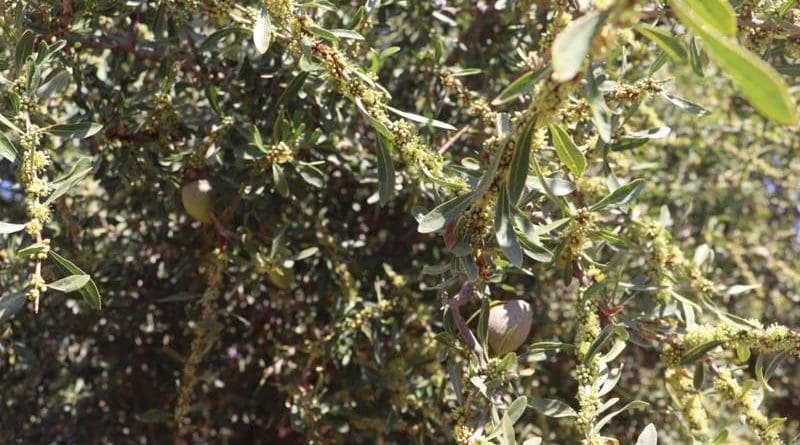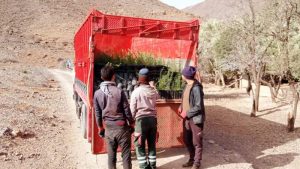2024 International Day of Argania: The Argan Tree’s Past And Present – OpEd
By Kiran Johnson and Michaela Creel
The Past:
Around 65 million years ago, when dinosaurs had just become extinct, Argan trees began to grow. They lived in what is now southwestern Morocco, surrounded by the first organisms recognizable to a 21st century human — rodents, birds, primates, horses and the first whales. The continents, as they are known today, were still forming, and drastic climatic changes were taking place on Earth. It is believed that Argan trees are one of the few species to survive these periods of change due to their ability to bear harsh conditions and remain in a state of dormancy during drought.
Fast forward to 1219: The first person on record to write about the Argan tree was Ibn Al Baytar. He was a botanist, physician, scientist and pharmacist, born in Malaga, Spain, in Al-Andalus. He collected plants predominantly in Spain and North Africa, recording their properties in detail. His systematic documentation of Islamic medicinal discoveries during the Middle Ages compiled the knowledge of Arabic, Persian, Amazigh, Greek, Latin and Romance languages, enabling him to find technical equivalents between each language. Eventually, Al Baytar found his way to Marrakech, Morocco, and wrote about the argan tree.
Oil lamps, baking meat, construction, medicine and fodder for livestock — the Amazigh people have a use for almost every part of the argan tree. For centuries, they have farmed argan trees, harvesting the fruits between July and September and drying them outdoors. The fruit’s shell is cracked with a rock, so that its kernels can be collected. These are roasted then ground into a pulp using a stone mill. The pulp is mixed with water to form a paste, which is kneaded by hand to extract the fruit’s oil. Nowadays, there are automated stone mills.
The tree is integral to Morocco’s landscape, dotting coastal hills and becoming more concentrated inland. With roots 20 times the size of the above-ground tree, argan trees anchor the soil, preventing desertification, which is crucial in a country that is already largely composed of desert. Argan trees are the defining species of a woodland ecosystem known as Arganeraie, that supports plants and animals found only in Morocco.
Even after surviving Earth’s changing temperatures and shifting continents, Argan trees still haven’t escaped peril. Overgrazing and exploitation of the tree for wood became a threat to argan groves in the 20th century, when the French Protectorate began clear-cutting large areas to supply fuel for growing cities in Morocco, Spain and France.
In 1988, UNESCO declared an argan forest of 2.5 million hectares in the southwest of Morocco as “La Arganeraie,” making it a biosphere reserve. This is a natural site designated to understand and manage how both biological and cultural diversity can be conserved alongside sustainable development. The reserve has played a central role in the region’s socio-economic activities, being a hub for tourism and production of argan products.
While these trees resisted natural climate changes over 65 million years ago, increased drought and rising temperatures once again threaten them. It’s not just argan trees, though — it’s forests all around the world that need to be protected, for the sake of the environment and the 1.6 billion people that rely on forests for their livelihoods.
The Present:
As of 2021, May 10th of every year was proclaimed the International Day of Argania. The day is intended to celebrate argan trees’ significance, socially, economically and environmentally. As a UNESCO Intangible Cultural Heritage of Humanity site, its roots run deep in Moroccan history and culture: it is a symbol of life and resilience to the country and represents the symbiosis between humans and nature. It has also become a key aspect of sustainable development efforts in Morocco and combating climate change.
While the global market for argan heats up, so do the arid lands of southwestern Morocco where many argan agro-forests and cooperatives thrive. Due to its durability and resilience, the argan tree is crucial in providing consistent income to farmers in regions, like the High Atlas Mountains, with ever-changing climates. On today’s International Day of Argania, support the women’s cooperatives and local farmers of Morocco who make it possible for people worldwide to experience the healing properties of argan, while also maintaining the land and culture, fueling more sustainable international consumption.
From sapling to oil, the High Atlas Foundation (HAF) has become intertwined with the production of argan, planting trees, and partnering with communities across Morocco. As the versed farmers of Morocco pass on centuries old techniques, HAF works alongside them to gain organic certification while building upon communities’ abilities to successfully produce and commercialize their own products. Since 2021, HAF has planted with 200 farming families in 17 provinces 32,948 Argan trees, enabled by partnerships with the United Nations Development Program, FRÉ Skincare, and Sapling (UK).
As 2024’s International Day of Argania comes and goes, HAF is reminded of crucial projects, from the developing argan fields in Essaouira to the socio-economic lessons of women’s cooperatives in the Al Houz province. We ask you to join us in celebrating Argan and the people who will foster its legacy for centuries to come.
About the authors:
- Michaela Creel, an undergraduate student studying International Affairs and Cultural Anthropology at Northeastern University and currently an intern at the High Atlas Foundation.
- Kiran Johnson, an undergraduate student studying Journalism and EnvironmentalScience at Northeastern University and currently an intern at the High Atlas Foundation.


